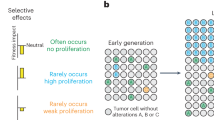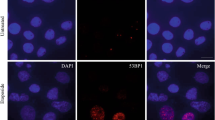Abstract
Most allelic pairs of DNA replicate synchronously during the S phase of the cell cycle. However, some genes frequently replicate asynchronously, i.e. genes on the X chromosome and imprinted genes. Earlier studies demonstrated an asynchronous pattern of replication in some precancerous and invasive squamous carcinoma of the cervix as well as in multiple myeloma. A high rate of asynchronous pattern was found in: (1) lymphocytes of individuals with solid tumors as well as in other malignancies; (2) amniocytes of genotypes with an extra chromosome 13, 18 and 21; (3) lymphocytes of young mothers of a Down syndrome pregnancy. The asynchronic pattern was not locus specific and was found in all loci analyzed. These findings suggested that the mechanism controlling the temporal order of replication could be altered in cells with a genetic predisposition to cancer or aneuploidy. In this study, we found a higher rate of asynchronous pattern in genotypes carrying inversions 2 and 9 and in balanced heritable translocations (p < 0.01) and an even higher rate in cases with a de-novo balanced translocation. The process of tumorigenesis may begin with a change in cell cycle regulation which includes the duplication, replication and segregation of genetic information. However, it remains unknown whether individuals with balanced chromosome rearrangements are at increased risk of developing cancer later in life.
Similar content being viewed by others
References
Amiel A, Litmanovitch T, Gaber E, Lishner M, Avivi L, Fejgin M (1997) Asynchronous replication of p53 and 21q22 loci in chronic lymphocytic leukemia. Hum Genet 101: 219–222.
Amiel A, Avivi L, Gaber E, Fejgin MD (1998a) Asynchronous replication of allelic loci in Down syndrome. Eur J Hum Genet 6: 359–364.
Amiel A, Kolodizner T, Fishman A et al. (1998b) Replication pattern of the p53 and 21q22 loci in the pre-malignant and malignant stages of carcinoma of the cervix. Cancer 83: 1966–1971.
Amiel A, Korenstein A, Gaber E, Avivi L (1999a) Asynchronous replication of alleles in genomes carrying an extra autosome. Eur J Hum Genet 7: 223–230.
Amiel A, Kirgner I, Gaber E, Manor Y, Fejgin MD, Lishner M (1999b) Replication pattern in cancer. Asynchronous replication in multiple myeloma and in monoclonal gammopathy. Cancer Genet Cytogenet 108: 32–27.
Amiel A, Reish O, Gaber E, Kedar I, Diukman R, Fejgin MD (2000) Replication asynchrony increases in women at risk for aneuploid offspring. Chromosome Res 8: 141–150.
Amiel A, Elis A, Sherker S, Gaber E, Manor Y, Fejgin MD (2001) The influence of cytogenetic aberration on gene replication in CLL patients. Cancer Genet Cytogenet 125: 81–86.
Boggs BA, Chinault AC (1994) Analysis of replication timing properties of human X-chromosomal loci by fluorescence in situ hybridization. Proc Natl Acad Sci USA 91: 6083–6087.
Boggs BA, Chinault AC (1997) Analysis of DNA replication by fluorescence in situ hybridization. Methods 13: 259–270.
Clurman BE, Roberts JM (1998) Cell cycle control: An overview. In: Vogelstein B, Kinzler KW, eds. The Genetic Basis of Human Cancer. New York: McGraw-Hill; pp. 175–191.
Cui H, Horon IL, Oglsson R, Hamilton SR, Feinberg AP (1998) Loss of imprinting in normal tissue of colorectal cancer patients with microsatellite instability. Nat Med 11: 1276–1280.
Dotan ZA, Dotan A, Litmanovitch T et al. (2000) Modification in the inherent mode of allelic replication in lymphocytes of patients suffering from renal cell carcinoma: A novel genetic alteration associated with malignancy. Genes Chromosomes Cancer 27: 270–277.
Ehrlich M (2000) DNA hypomethylation and cancer. In: Elirlich M, ed. DNA Alterations in Cancer: Genetic and Epigenetic Changes. Eaton Publishing; pp 273–291.
Feinberg AP (1998) Genomic imprinting and cancer. In: Vogelstein B, Kinzler KW, eds. The Genetic Basis of Human Cancer. New York: McGraw-Hill; pp 95–107.
Gunaratne PH, Nakao M, Ledbetter DH, Sutcliffe JS, Chinault AC (1995) Tissue-specific and allele-specific replication timing control in the imprinted human Prader-Willi syndrome region. Genes Dev 9: 808–820.
Jones PA, Gonzalgo ML (1997) Altered DNA methylation and genome instability: a new pathway to cancer. Proc Natl Acad Sci USA 94: 2103–2105.
Kitsberg D, Selig S, Brandeis M (1993) Allele-specific replication timing of imprinted gene regions. Nature 364: 459–463.
Knoll JHM, Cheng SD, Lalande M (1994) Allele specificity of DNA replication timing in the Angelmann/Prader-Willi syndrome imprinted chromosomal region. Nat Genet 6: 41–46.
Knudson AG (1993) Antioncogenes and human cancer. Proc Natl Acad Sci USA 90: 10914–10921.
Look AT (1998) Genes altered by chromosomal translocation in leukemia and lymphomas. In: Vogelstein B, Kinzler KW, eds. The Genetic Basis of Human Cancer. New York: McGraw-Hill; pp 109–141.
Mukherjee AB, Murty VVVS, Chaganti RSK (1992) Detection of cell-cycle stage by fluorescence in situ hybridization: its application in human interphase cytogenetics. Cytogenet Cell Genet 61: 91–94.
Qumsiyeh MB (1995) Impact of rearrangements on function and position of chromosomes in the interphase nucleus and on human genetic disorders. Chromosome Res 3: 455–465.
Qumsiyeh MB (1999) Structure and function of the nucleus: anatomy and physiology of chromatin. Cell Mol Life Sci 55: 1129–1140.
Randhawa GS, Cui H, Barletta JA et al. (1998) Loss of imprinting in disease progression in chronic myelogerous leukemia. Blood 91: 3144–3147.
Rowley JD (1999) The role of chromosome translocations in leukemogenesis. Semin Hematol 3: 659–672.
Selig S, Okumura K, Ward DC, Cedar H (1992) Delineation of DNA replication time zones by fluorescence in situ hybridization. EMBO J 11: 1217–1225.
Vilain A, Vogt N, Dutrillaux B, Malfoy B (1999) DNA methylation and chromosome instability in breast cancer cell lines. FEBS Lett 460: 231–234.
White LM, Rogan PK, Nicholls RD, Wu BL, Korf B, Knoll JHM (1996) Allele specific replication of 15q11-q13 loci: a diagnostic test for uniparental disomy. Am J Hum Genet 59: 423–430.
Author information
Authors and Affiliations
Rights and permissions
About this article
Cite this article
Amiel, A., Levi, E., Reish, O. et al. Replication status as a possible marker for genomic instability in cells originating from genotypes with balanced rearrangements. Chromosome Res 9, 611–616 (2001). https://doi.org/10.1023/A:1012966221692
Issue Date:
DOI: https://doi.org/10.1023/A:1012966221692




